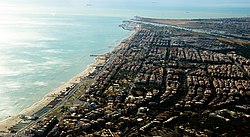Ostia | |
|---|---|
 Aerial view of Ostia, with the Tiber and its mouth in the background | |
| Coordinates: 41°43′59.68″N 12°16′44.18″E / 41.7332444°N 12.2789389°E | |
| Country | Italy |
| Region | Lazio |
| Province | Metropolitan City of Rome Capital |
| Comune | Rome |
| Elevation | 5 m (16 ft) |
| Population (2022) | |
| • Total | 91,342[1] |
| Demonym | Lidensi/Ostiensi |
| Time zone | UTC+1 (CET) |
| • Summer (DST) | UTC+2 (CEST) |
| Postal code | 00121 - 00122 |
| Dialing code | 06 |
Ostia (/ˈɒstiə/, Italian: [ˈɔstja]; officially Lido di Ostia) is a large neighbourhood in the Municipio X of the comune of Rome, Italy, near the ancient port of Rome, which is now a major archaeological site known as Ostia Antica.[2] Ostia is also the only municipio or district of Rome on the Tyrrhenian Sea, and many Romans spend the summer holidays there. It is entirely situated within the municipality of Rome and is the city's seaside resort.
Ostia was the port city of ancient Rome; it had a strategic function for trade, especially for the supply of grain, and as the main base of the Roman navy. It had a fundamental function during the Punic Wars, and after the final destruction of Carthage, and the end of Macedon's independence; by the latter half of the 2nd century BC, Roman control over all of what was later to be dubbed Mare Nostrum ("our sea") had been established.
The ancient city of Ostia stood in a strategic point near the mouth of the Tiber and the sea, which at the time was closer to the city. The modern seaside resort, Lido di Ostia, is in fact located about 5 km (3 miles) south-west of the ancient city and about 28 km from center of Rome (17.4 miles).
- ^ "Tavola 3 - Popolazione maschile e femminile iscritta in anagrafe al 31 dicembre 2016 per zone urbanistiche, stato civile e particolari classi di età". comune.roma.it (in Italian). Archived from the original on 27 August 2017. Retrieved 27 August 2017.
- ^ "Ostia - Italy, Map, History, & Facts". britannica.com. Retrieved 1 January 2020.

